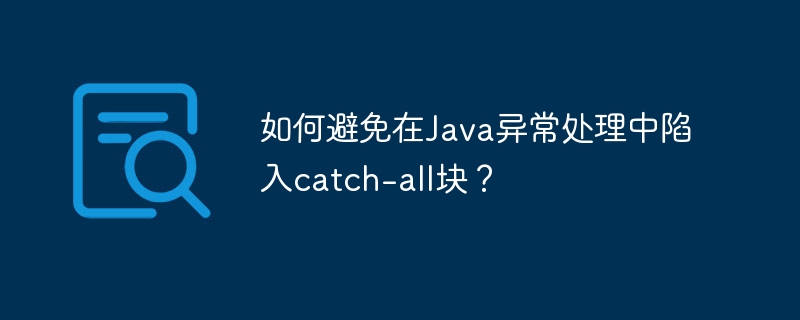
Avoid using catch-all blocks to increase the effectiveness of exception handling: use more specific exception handling blocks that catch only the exceptions required for application handling. This allows different types of exceptions to be distinguished and appropriate actions to be performed on them. Practical example: By using a more specific exception handling block, the application can distinguish FileNotFoundException from other exceptions and provide more specific feedback messages and appropriate actions.

How to avoid falling into the Catch-All block in Java exception handling
The Catch-all block is a catch-all block that catches all unhandled Exception handling block. Although it may be convenient to use it in some situations, the use of catch-all blocks should be avoided because it prevents unhandled exceptions from reaching other blocks that might handle them.
The best way to avoid catch-all blocks is by using more specific exception handling blocks that catch only the exceptions that your application needs to handle. For example:
try {
// 您的代码
} catch (IOException e) {
// 处理 IO 异常
} catch (SQLException e) {
// 处理 SQL 异常
} catch (Exception e) { // 仅在所有其他异常处理失败时才使用
// 处理其他异常
}This approach allows applications to handle specific types of exceptions and perform appropriate actions for them.
Practical Case
Consider an application that reads data from a file. The application may throw FileNotFoundException due to reasons such as not being able to find the file. If you use a catch-all block, your application will not be able to distinguish FileNotFoundException from other exceptions, such as IOException or NullPointerException.
Applications can differentiate between these exceptions and take appropriate action by using a more specific exception handling block using the following code:
try {
// 您的代码
} catch (FileNotFoundException e) {
System.out.println("文件未找到。");
} catch (IOException e) {
System.out.println("IO 异常。");
} catch (Exception e) {
System.out.println("发生未知异常。");
} This will allow applications to provide more specific feedback messages and target Different exception types perform appropriate actions. For example, an application can prompt the user for a different file path in case of FileNotFoundException and try to read the file again in case of IOException.
By avoiding catch-all blocks and using more specific exception handling blocks, an application can handle exception situations more efficiently, thereby improving its robustness and user experience.
The above is the detailed content of How to avoid getting stuck in catch-all block in Java exception handling?. For more information, please follow other related articles on the PHP Chinese website!
